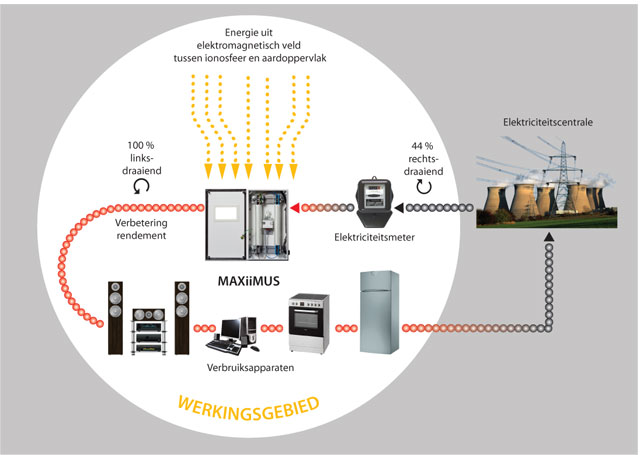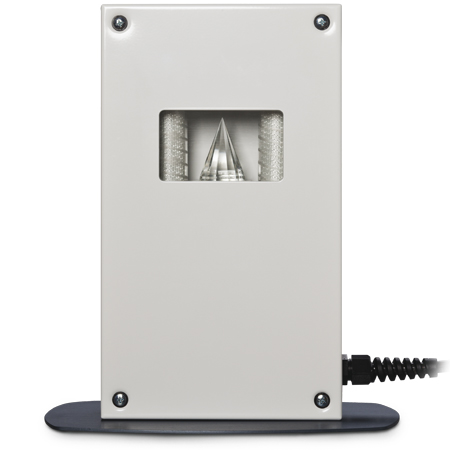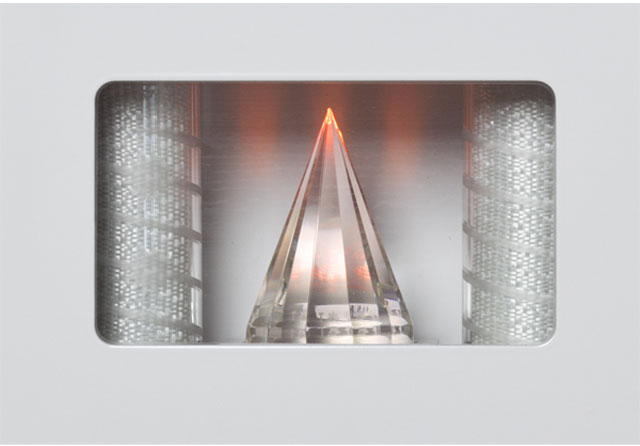Kemp Elektroniks MAXiiMus P16 Shunt Conditioner


Ron Kemp, a consummate tweaker, founded Kemp Elektroniks in 1999 in Amsterdam. He regards himself as more of music lover than an audiophile and after getting to know him during a review of his products years ago, I would be the first to agree. Kemp is constantly working to improve existing products through tweaks, rather than proffering expensive, new products that, let’s face it, only a few of us can afford. Just take a look at all the tweaks on Kemp’s website and you will agree that he is totally wedded to the idea of helping music lovers achieve better sound with the equipment they already own.
Back in 2009, a series of reviews appeared in Stereo Times about Kemp’s Schumann Resonance Plugs (see archives). Each article lauded this product, which is based on Otto Schumann’s discovery of the fundamental resonant frequency of our home planet’s atmosphere, 7.83 Hz. (There are other frequencies inherent in the dimension and physical properties of Earth, but 7.83 Hertz is fundamental and it is the frequency designers of these tweaks choose to work with.) Kemp’s Resonance Plugs provided a noticeable improvement in the sound, certainly worth the $300 they cost. Shortly thereafter, Acoustic Revive in Japan released their own Schumann device, the RR-77 (the more powerful RR-888 followed some years later). The RR-77 was a huge success the world over.
But it was Ron Kemp who first told me about the effects of the Schumann phenomenon in the listening environment. And his latest creation, the MAXiiMUS P16 (the P16 hereafter), is the subject of this review. It may just be the most intriguing and powerful tweak I’ve ever encountered.
Background
The Kemp P16 was originally designed by Fostac of Switzerland. The late Hans Seelhofer, owner/designer, started the company in 1989. Today it is directed by a dedicated group headed by Bernhard Seelhofer, Hans’s son. In early 2011, Kemp contacted Fostac but unfortunately, this was at the time of Hans Seelhofer’s untimely death, which resulted in no response. In 2014, Maxii Energii of Germany took over the production of the Maximus and contacted Kemp and they graciously sent him a sample prototype to try. After a series of evaluations, Kemp added his own touches to the design (the Lo Power AC Cord, a three-fold suppression capacitor at the neon bulb, and a set of Perfect Sound Damper isolation feet). After auditioning these changes, Maxii Energii wholeheartedly granted him permission to officially obtain the exclusive rights to produce the Kemp Elektroniks MAXiiMUS. Having set his sights on a USA debut, who better for Kemp to ask to test his latest tweak than the staff at Stereo Times!

What I found most interesting about the P16 is that, in its original Fostac iteration, was designed to harmonize electrosmog. Electrosmog is a term for electromagnetic contamination that includes electricity, cell phones, WiFi and radio & television stations, just to name a few. Fostac claims that electrosmog could be harmful to both humans and animals. Exposure to electrosmog can produce symptoms such as headaches, interrupted sleep patterns, irritability, nervousness, a lack of concentration and even a distortion in hearing. Lowering electrosmog offers a homeopathic benefit, improving overall health and sense of well-being. A few years later, multiple customers noticed a reduction in their energy consumption as an unexpected benefit. (Fostac claims that their products can reduce one’s electrical bill by up to 30%!)
That I might be able to sleep better and gain better mental acuity in addition to lowering my electrical bill, both as side benefits to improving my audio system, is a challenge I would take any day of the week.

I received two Kemp P16 devices within a few days. Kemp had recommended having one on each side of my listening room due to the size (21 x 17 x 8) of my listening room. The P16 is an industrial built, 12″ tall, rectangular, white metal box sporting a small glass window. Behind the window one sees an elongated, pyramidal glass object centered between two cylindrical shaped tubes Kemp calls accumulators. If that isn’t weird enough, the pyramid actually glows when the unit is plugged in and is said to be partially responsible for the enhanced high frequency brilliance (in the gigahertz region).
What is it? What does it do? And even if I did get an explanation, I wonder if I (or you) could comprehend it, let alone believe it.
Vaguely, I remember Jack Bybee mentioning that crystals were essential components in products like the RR-888, Stein Harmonizers, IPC Energizers and, as well, his own Room Enhancers. Hmm, well, this certainly looks like the biggest crystal I’ve ever seen. Besides the fact that the P16 glows when powered up, there’s seems to be nothing much else to it; not even a power switch! Just a glass window and a captive AC cord. Once plugged into your AC conditioner (highly recommended) your only goal is to find an optimum location for the P16 (Kemp recommends starting right behind your loudspeakers).
Having used the P16s for awhile, I now consider them to be heaven sent. Because its performance rivals far more expensive tweaks, like an entire arsenal of Stein Harmonizers and Magic Stones and the IPC Acoustic EQ Panels and Sound Power AC conditioner/enhancer.
Performance
The thing I noticed in the first hour of listening with the P16s powered up was…nothing. Or if I did notice anything at all, it was perhaps an ever-so-slight sense of improved treble energy. Nothing like what Kemp had suggested I would hear. I feared that, in the context of my many existing tweaks, Kemp’s latest product might turn out to be a dud.
 I had a sneaky suspicion that the effects of the P16s might develop gradually and require patience to appreciate. So I went about my day, returned about six hours later, and once again dialed up some of my favorite tunes on my redoubtable Laufer Teknik Memory Player. Sure enough, Sunny from Frank Sinatra’s and Duke Ellington’s classic 1968 collaboration “Francis A & Edward K” sounded cleaner, more crystal-clear and quieter than I ever heard before. Of course, I thought to myself, this is how my system always performs late at night when the city is at rest. It’s 11:00 PM so, right on schedule. But on such an old recording I’d not experienced this level of quiet before nor this sense of transformation, sounding like a remastering job. It was absolutely breathtaking to “see” the front wall all but disappear. For the first time in all my experience with tweaks, I heard an improved specificity of depth in individual voices and instruments, not just overall sound stage.
I had a sneaky suspicion that the effects of the P16s might develop gradually and require patience to appreciate. So I went about my day, returned about six hours later, and once again dialed up some of my favorite tunes on my redoubtable Laufer Teknik Memory Player. Sure enough, Sunny from Frank Sinatra’s and Duke Ellington’s classic 1968 collaboration “Francis A & Edward K” sounded cleaner, more crystal-clear and quieter than I ever heard before. Of course, I thought to myself, this is how my system always performs late at night when the city is at rest. It’s 11:00 PM so, right on schedule. But on such an old recording I’d not experienced this level of quiet before nor this sense of transformation, sounding like a remastering job. It was absolutely breathtaking to “see” the front wall all but disappear. For the first time in all my experience with tweaks, I heard an improved specificity of depth in individual voices and instruments, not just overall sound stage.
Unlike all my other tweaks, the Kemp P16 has this ability to create an ultra-relaxed, and ultra-clean atmosphere, a crystal-clear view, deep into the recording. It offers a more relaxed and natural feel to the overall presentation. One is granted an ease and refinement that is usually reserved for only the most elusive and expensive of components.
Turn up the Quiet
Bedazzled, I next played Follow Me, my favorite track from this legendary recording. And once again, the added buoyancy, ease, clarity and dimension were startling. I could hear more in this recording than ever before. The sense of quiet that the P16 extends into the room was uncanny and allowed a profound comprehension of Ellington’s incredible genius. The sense of realism of the musicians encircling Sinatra, whose voice appears even more dead-center and locked-in on a multi-layered plane, was more life-like than I had ever heard it before.
This decent recording was transformed by the P16 into sounding more like a recent recording! Somehow, the 1968 date stamp was miraculously modernized (albeit not completely). The ability of the P16 to add extra levels of dimensionality, x-ray-like transparency, ease, and natural fluidity with a razor-sharp focus, was nothing short of mindboggling.
Nancy Wilson, Sarah Vaughn, Ella Fitzgerald, Miles Davis, Shirley Horn, Sonny Rollins, John Coltrane—I could go on and on about the improved vivacity and increased ease, the harmonic grace and flow. If you’re a music lover first, and an audiophile second, this type of improvement should have you praising the P16 to the skies. The sheer quiet, the sense of ease, melodic flow and fidelity is so enhanced that for the next few weeks all I could do was shake my head in disbelief.
One is tempted to ask how is this happening? What’s that glass pyramid actually doing that so impacts performance? I believe that even the folks at Fostac can only come up with hypotheses, speculations for which there may be intriguing, even compelling, scientific reasoning, but for which there is absolutely no experimental proof.
Jack Bybee, retired physicist/designer for Bybee Technologies, has been making unusual claims to his products for decades. We know his gadgets work, we hear it; but as to how they work, there are two problems. First, we have only the designer’s (highly informed) speculations on how they might work; and second, understanding those ideas, those speculations, requires a profounder understanding of some of the most esoteric areas of physics than we are likely to possess. As Richard Feynman famously said, Anyone who claims to understand how quantum mechanics works, doesn’t.
Not long ago, our own Russell Lichter wrote with amazement about the sonic effects of Bybee Room Neutralizers, perhaps Bybee Technologies’ most outlandish product to date (here). And knowing first hand how effective Jack Bybee’s products are at removing various distortions in my own system(s) prompted me to reach out to him. In a telephone conversation, Bybee graciously agreed to investigate published data on the P16s. After visiting both Kemp’s and Fostac’s websites, he called me back and said, I do think the MAXiiMUS 16 works similar to the Bybee Technology Room Neutralizers…the RNs were designed to use RFI that created by the amplifier. This, in turn energizes the special carbon-based crystals utilized in the RNs to oscillate [vibrate] at the same frequency as nitrogen which comprises about 70% of the air in the atmosphere. This oscillation of nitrogen makes the air in the listening environment more active and reduces the resistance causing the music signal to propagate more freely. Therefore we hear the music more clearly: not unlike what the conductor of a Symphony Orchestra might experience from the podium. It may be possible that the MAXiiMUS 16 does this more effectively and with all gases in the atmosphere. Based on what you are experiencing this is quite possible.”
On the Road
I don’t have to understand how something works to know whether or not it does. Especially something that performs as powerfully and effectively as the Kemp P16. The evidence is in the performance. Therefore, I recently took the P16 over to the home of Dave Caplan, contributor and chief tweakaholic. After a short listening session to get a fresh handle on his fabulous-sounding system (Apogee loudspeakers, PS Audio Perfect Wave transport and DAC and his latest addition, the Wells Audio Innamorata Signature amplifier — reviewed here) we decided to power up the P16. Within a few minutes of plugging it in and centering it between the loudspeakers, I was astonished at Ahmad Jamal’s piano that had somehow shifted from a small-dimensioned instrument in a small soundstage into a deeper, more dimensional and authentic one. I want to emphasis the word authentic because with the P16 the system sounded more like real musicians in the room. I was also impressed by how consistent the P16’s sonic benefits were in our two very different systems and listening spaces. Moreover, I had bought only a single unit. Imagine what two P16s would have done.
Conclusion
 I offer no apologies for owning a bevy of Bybee products, six Stein Harmonizers and various Magic Stones, four IPC Acoustic EQ Panels, three IPC Energizers, a single IPC Sound Power AC conditioner/enhancer and two Acoustic Revive RR-888s. These devices have allowed my room to sound much bigger than its actual dimensions and have as well allowed my Sunny Supreme loudspeaker’s 18″ woofers to move as fast as ever.
I offer no apologies for owning a bevy of Bybee products, six Stein Harmonizers and various Magic Stones, four IPC Acoustic EQ Panels, three IPC Energizers, a single IPC Sound Power AC conditioner/enhancer and two Acoustic Revive RR-888s. These devices have allowed my room to sound much bigger than its actual dimensions and have as well allowed my Sunny Supreme loudspeaker’s 18″ woofers to move as fast as ever.
The Steins add by expanding on high-frequency sparkle and three-dimensionality, while the Acoustic Revives offer a greater feel for harmonics. The IPCs seem to have the greatest impact (perhaps due to their large physical dimensions) in enhancing the acoustic size of the room. Indeed, the effectiveness of the IPC’s hasn’t been rivaled by any tweak till the arrival of the P16s. In my opinion, nothing has proven to be as effective and powerful, regardless of price. The P16, at a little over $2k each, is the best tweak for the money that we have heard. Bar none.
I’m awaiting to hear from all our contributors who have placed their purchase orders with Kemp to describe their findings in the coming weeks. I, for one, have not experienced before any tweak of this magnitude at this asking price. I would compare the improvement on a par with $10,000 worth of Stein Harmonizers and Magic Stones. Easily on par with the IPCs that retail for $15,000. What the Kemp MAXiiMUS P-16 sonically packs in a small metal box has exceeded all my expectations. Ladies and gentlemen, the Kemp MAXiiMUS P-16 Shunt Conditioner is a major component masquerading as a mere tweak. An easy vote for Most Wanted Component Publisher’s Choice 2016! 

clement perry


I’ve been brutally honest with Clement Perry (CP herein), regarding my encounters with magic boxes and components that claim to improve a system’s sound in mysterious ways. If I don’t hear it, I say just that, I don’t mince words… life’s to short. Only recently did I hear a clearly positive effect from the CAD Ground Control – a plug-it-in-I-have-no-idea-how-it-works tweak – for which I wrote a positive review (stay tuned!).
CP and I usually listen together in the afternoon hour due to our wives’ work schedules, and CP’s upstairs system, which has long consisted of the Sunny Supreme loudspeakers, Behold electronics and the Laufer Teknik Memory Player, always sounds great. Make that GREAT! After a listening session, most audiophiles would consider it audio perfection, but CP, by nature, is a tweaking man. He’ll give me a call and ask for my ear, offering only that he’s been busy tweaking and mildly curious if I notice anything different, so it wasn’t out of the ordinary to get yesterday’s invitation to slip over for a listening session. It being a late night session was the only new variable.
Primed for the session, CP ran through a couple of incidental songs as we settled in. After a few tunes, as Ahmad Jamal’s ‘Morning Mist’ played, I noticed what seemed to be added resolution, detail and nuance coming from a renewed soundstage that appeared far deeper and beyond the usual. I chalked this up to late night better power. Jamal’s piano work was strong, forceful and appeared possessed with a rhythmic power that was brilliantly rendered. The sax on Marc Cary’s When I think Of You was huge and commanded my complete attention. I remarked that it was possibly the best sax recording I’ve ever heard. Al Jarreau’s We Got By, a track I’ve heard often, appeared unlike any previous listen. There was more air around each instrument, with snappier transients, while Jarreau’s voice had greater body and breadth in both tone and texture.
I sat both stunned and perplexed and must have said “Wow” a hundred times. Descriptives suddenly escaped me. I recall being embarrassed at saying “Wow” again and again. How is it possible that a world class system like CP’s could be so seriously improved? “Okay, now tell me what the heck you did”, I said. CP just smiled and pumped out more tunes – we listened to 30 in all (I know this because I Shazam’d each one on my iPhone!).
 All instruments appeared better defined and rendered in higher resolution with more air around each. Transients had more snap and life. Double basses pulsed with greater definition and instrument depth. The music seemed more relaxed and effortless, so much so that time seemed affected – songs felt slower and longer. Even highly commercial recordings, like Michael Jackson’s The Lady In My Life from “Thriller” had more life and density (sadly, we found out the very next morning, legendary writer/musician Rod Temperton, who penned that song for Michael Jackson had passed away during the night). Hearing into that production via this new tweak made me aware of how much care was taken to make that music… layers of goodness. Thank you for all the music you blessed us with over the past 35 years Mr. Temperton.
All instruments appeared better defined and rendered in higher resolution with more air around each. Transients had more snap and life. Double basses pulsed with greater definition and instrument depth. The music seemed more relaxed and effortless, so much so that time seemed affected – songs felt slower and longer. Even highly commercial recordings, like Michael Jackson’s The Lady In My Life from “Thriller” had more life and density (sadly, we found out the very next morning, legendary writer/musician Rod Temperton, who penned that song for Michael Jackson had passed away during the night). Hearing into that production via this new tweak made me aware of how much care was taken to make that music… layers of goodness. Thank you for all the music you blessed us with over the past 35 years Mr. Temperton.
It wasn’t until all songs had been played that CP revealed the Kemp MAXiiMUS P-16 Shunt Conditioner, pointing out one behind his right speaker (mounted 5 feet from the floor). CP confirmed that my descriptions of what I was hearing meshed nearly word for wordwith his own. Until this blind listening test, the most undeniably outstanding tweak I had experienced was the High End Novum PMR Resonator on a visit to the home of Dan Secula. Although CP had one staring right at me, I only noticed what a sonic impact it had when Dan adjusted it by moving it a few feet! I came away wanting one. The Kemp MAXiiMUS P-16 ranks right up there with the Novum PMR in my experience. I don’t really know how it does what it does to the electricity and air to affect sound so dynamically, I just know that I want one. The Kemp MAXiiMUS P-16Shunt Conditioner is an affordable audio wonder.

Over the past ten plus years or so, I’ve had the opportunity to revisit New Jersey on a fairly regular basis. The primary reason for these visits is to see family and also reconnect with long-time friends. An additional benefit to these trips has been the opportunity for me to drop in on Clement Perry whenever I’m in town. These particular visits not only allow me to check out Clement’s continuously evolving audio system but also allow him to introduce me to various nearby ethnic restaurants with a wide variety of choices for different types of cultural cuisine. It’s really hard to beat the combination of great food and great sounds during these visits which is perhaps why I’ve actually increased the regularity of my visits, both to the East Coast and Clement’s Audio Emporium.
Focusing just on Clement’s audio system alone, the things that have remained constant over many years are his reference Behold electronics, Laufer Teknik’s Memory Player 64 (i.e., including various significant updates during the time he’s had this unit in place) and finally those big, and I mean REALLY BIG, Sunny loudspeakers. Everything else has been pretty much up for grabs including cables, room treatment and/or AC line conditioning. As a result, and with regular visits, I have become quite familiar with what I consider to be the “house sound” at Clement’s place. For the most part – I know what to expect when listening to music there and am always quite pleased with the excellent sound of his system. However, there is something that continues to amazes me and that is the way in which Clement introduces various new tweaks into his system. Typically these are relatively small tweaks and often the results are rather profound. Clearly any departure from the already superb house sound is easily noticeable and at times, I feel as though I’m somewhat of a guinea pig when I’m asked to sit down for a quick listen and then relate back to my host what I just heard.
Most recently, and starting from an already outstanding high-end audio system that provides a sound that faithfully captures the essence of music, including high levels of transparency, detail, inner resolution, sound staging, power, dynamics and control, as well as wonderful reproduction of frequencies from the very highest notes to the deepest, the system now incorporating the Kemp MAXiiMUS P-16 has simply reached a new level of sonic excellence. In fact, with this latest change, the difference from my previous listening experiences at Clement’s was nothing short of profound. Specifically, what captured my attention was a compelling sense of “you are there” especially with vocals (i.e., either male or female). The sound of singers was wonderfully suspended in the sound stage, focused dead center and right before me. Additionally, individual images were more fleshed out and superbly dimensional. Added to the high degree of realism especially for vocals, the sound was simply killer!
Despite this enhanced presence, the sound did not seem to be thrust forward but instead it created a heightened sensation of being able to visualize whichever performer was being featured in the recording. Additionally, it helped to create an emotional connection for me to the music. Individual images were more fleshed out and very dimensional. Added to the high degree of realism especially for vocals = killer sound!!! It was truly more about how I felt while listening, not just simply how much better/different the sound was.
Without any need to strain – there was clearly a noticeable level of improvement in the areas of texture, warmth and organic feel. This allowed the sound to be very natural and authentic both in terms of tonal accuracy and lifelike presence. What was also particularly noticeable was the significantly enhanced ability to easily discern the artist’s delivery and follow the subtle nuances of their unique style. Overall it was absolutely a wonderful experience and something that literally caught more off-guard. In fact – as good as CP’s system was before; I find it hard to imagine going back to the way things were prior to the introduction of this latest tweak. Reproduced music has become much more of a very special event, and almost as if I were being provided a personal concert with some of the best seats I’ve ever had, rather than simply listening to a great audio system with merely interesting and/or even great music.


greg voth
Specifications:
Price: Europe and USA: $€1936 = +/- $2176.
Color white (RAL 9016)
Weight 4.7 kg / 10 lbs.
Sizes 32.3×18.8×6.2 cm / 12.7×7.4×2.4″ (without bottom plate)
Available with a 5 feet Power Cord or an IEC inlet.
KEMP ELEKTRONIKS
Address:
Quellijnstraat 15
1072 XM Amsterdam
The Netherlands
Tel: +31(0)20-7764464
Website: www.kempelektroniksshop.nl
Email: info@kempelektroniks.nl
Stereo Times Masthead
Publisher/Founder
Clement Perry
Editor
Dave Thomas
Senior Editors
Frank Alles, Mike Girardi, Russell Lichter, Terry London, Moreno Mitchell, Paul Szabady, Bill Wells, Mike Wright, and Stephen Yan,
Current Contributors
David Abramson, Tim Barrall, Dave Allison, Ron Cook, Lewis Dardick, John Hoffman, Dan Secula, Don Shaulis, Greg Simmons, Eric Teh, Greg Voth, Richard Willie, Ed Van Winkle, Rob Dockery, Richard Doran, and Daveed Turek
Site Management Clement Perry
Ad Designer: Martin Perry







Be the first to comment on: Kemp Elektroniks MAXiiMus P16 Shunt Conditioner